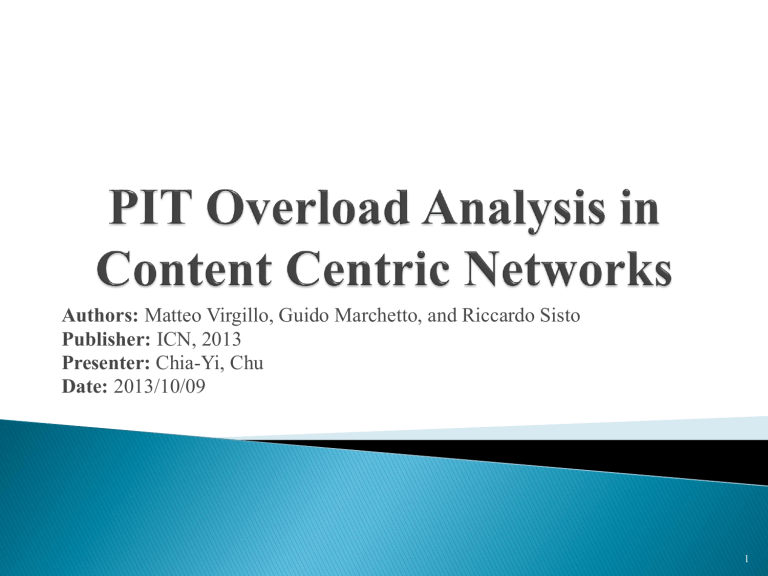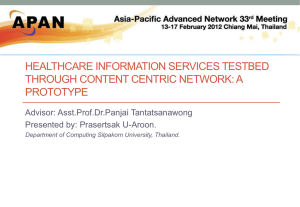PIT Overload Analysis in Content Centric Networks Authors

Authors: Matteo Virgillo, Guido Marchetto, and Riccardo Sisto
Publisher: ICN, 2013
Presenter: Chia-Yi, Chu
Date: 2013/10/09
1
Introduction
Content Centric Networking
Problem Description
Related Work
PIT Resilience Analysis
2
Providing a performance evaluation of some possible
PIT architectures in terms of resilience to overload conditions.
Experiments are conducted by means of an ad-hoc simulator, designed to recreate the behavior of a CCN network and to track memory usage at CCN nodes.
3
Interest packets
◦ request a (piece of) resource
◦ include the content name
in the form of a Uniform Re-source Identifier (URI)
◦ plus a set of parameters useful for Interest processing.
Data packets
◦ responses to client requests
◦ be used to deliver pieces of data
4
CCN nodes are equipped with three data structures:
1.
Content Store (CS)
where Data packets are cached. Each Interest arrival causes a
Content Store lookup
2.
Pending Interest Table (PIT)
which is the data structure where routers annotate forwarded
Interests and the respective arrival interfaces.
3.
Forwarding Information Base (FIB)
which is the equivalent of the IP routing table.
5
When a client generates an Interest, each router in the path towards the destination adds an entry in its PIT.
The entry remains in the PIT for a time interval called
LifeTime.
If the LifeTime expires and the response has not yet arrived, the memory is released.
6
PIT is used to maintain the state of each active flow.
It grows with users sending their Interests and shrinks when Data packets arrive at the router.
The PIT size might represent a bottleneck for the entire
CCN infrastructure.
Might be exacerbated by a massive usage of long
Interest LifeTimes
◦ increase the number of simultaneous entries in the PIT
7
30s is considered a safe value
◦ longer timers may be undesirable for intermediate proxies placed between the server and the client.
◦
FaceBook and some web-based mail applications, which to our experience often use timers of more than one minute.
We have to consider that one or more malicious users could craft artificial requests with the purpose of filling the available PIT memory on routers
◦ implementing a Distributed Denial of Service (DDoS) attack.
8
9
Design issues
◦ “On content-centric router design and implications.”
presents an efficient router design and describes some possible usage scenarios.
◦ “Scalable ndn forwarding: Concepts, issues and principles.”
identifies key issues related to the protocol fast speed implementation and establishes some principles to be observed in order to design scalable forwarding architectures.
◦ “A reality check for content centric networking.”
presents a feasibility study of CCN and concludes that CCN nodes based on current technologies would still be unable to sustain requests arrival rates at the Internet scale.
10
Data Structure
◦ “On pending interest table in named data networking.”
proposes a tree-like PIT structure
◦ “Dipit: a distributed bloom-filter based pit table for ccn nodes.”
present a PIT architecture based on Bloom Filters.
11
Privacy problem
◦ “On preserving privacy in content-oriented networks.”
◦ “Networking named content.“
◦ “Voccn: Voice-over content-centric networks.”
Solutions to attacks
◦ “Mitigate ddos attacks in ndn by interest traceback.”
◦ “Dos & ddos in named-data networking.”
12
Considering three possible architectures
1.
Simple PIT: storing all the bytes that compose an URI.
2.
Hashed PIT: storing fixed length entries evaluated as hash values of the URIs.
3.
DiPIT: multiple Bloom Filters placed in each router interface.
13
Develop a full custom event-driven Java simulator
◦
Plan to use NS-3 based NdnSIM CCN simulator in the future
To recreate realistic scenarios
◦ real structure of the Telecom Italia network
◦ subscriptions currently active in the Telecom Italia network around 9 million
◦ access bandwidths are considered uniform for simplicity and equal to 7Mbps (download ) and 1 Mbps (upload)
◦ overall header size of the protocols underlying CCN is assumed fixed to 20 bytes .
14
15
Zipf- Mandelbrot probability distribution
◦ properly model the behavior of users in a content distribution P2P network
◦ 𝑝 𝑖 =
1
(𝑖+𝑞) 𝛼
∀𝑖 ∈ [1, 𝑁]
◦ p(i) is the probability of extracting the i-th content available in the network, q and 𝛼 are two parameters that fixed to 𝛼 = 0.55, q = 25 for a residential ISP , and N is the total amount of resources.
Download requests are modeled using a Poisson process with average rate equal to 500 requests per second.
◦ an average value of around 12 million simultaneously active downloads in the steady state.
16
fix the PIT size to 1 GB
◦
In the DiPIT case, this value refers to the overall available filters memory
Attack parameters
◦
Maximum aggregate attack bandwidth of 4 Gb/s
◦
Interest LifeTimes values that vary between 4s and 180s
17
I scenario – SimplePIT
◦ stores the entire URI in the memory
◦ selected 1000 bytes, each malicious URI has a valid 13 bytes prefix
◦
◦
𝐵 𝑎𝑡𝑡𝑎𝑐𝑘𝑒𝑟𝑠
𝐼𝑛𝑡𝑒𝑟𝑒𝑠𝑡
= 2𝐺𝑏𝑝𝑠, 𝐿𝑖𝑓𝑒𝑇𝑖𝑚𝑒 = 4𝑠𝑒𝑐 𝑎𝑡𝑡𝑎𝑐𝑘𝑒𝑟𝑠
= 1033𝑏𝑦𝑡𝑒𝑠(1013
𝑈𝑅𝐼
◦ (2∗10
9
)𝑏𝑝𝑠
= 242013
𝐼𝑛𝑡𝑒𝑟𝑠𝑒𝑡
(1033∗8)𝑏𝑖𝑡𝑠 𝑠𝑒𝑐
◦
242013 ∗ 4 = 968,052 𝑒𝑛𝑡𝑟𝑖𝑒𝑠 ≈ 980𝑀𝐵
+ 20
𝐻𝐸𝐴𝐷𝐸𝑅
)
18
II scenario – HashedPIT
◦ storing a fixed length entry for each URI in transit
◦
Using SHA-1 hashing algorithm
◦ size for an attacker's URI is 20 bytes, according to the SHA-1 output digest (160 bits)
◦
Longer URIs are useless as would be reduced to 20 byte strings by CCN nodes.
19
III scenario – DiPIT
◦
The central PIT is split into multiple smaller per-interface
PITs, each implemented by a Counting Bloom Filter data structure.
◦
4 hash functions, simplicity 8 bit counters and no counter over flow.
◦ 𝑓𝑎𝑙𝑠𝑒 𝑝𝑜𝑠𝑡𝑖𝑣𝑒 𝑝𝑟𝑜𝑏𝑎𝑏𝑖𝑙𝑖𝑡𝑦 = (1 − 𝑒
− 𝑘∗𝑛 𝑚
) 𝑘
◦ k is the number of hash functions, n is the number of elements currently in the filter, and m is the total size of the filter.
20
21
1.
2.
None of the analyzed PIT architectures is overloaded during normal operation in the considered network scenario. Even with a low intensity attack, memory usage is reasonable and no retransmissions are observed.
There are significant weaknesses in all the architectures when the attack intensity grows.
22
23
HashedPIT is the architecture most affected by the considered attack
SimplePIT is the architecture most resilient for the reasons explained above.
The DiPIT has an intermediate behavior.
24
Other specific attacker behaviors
1.
2.
3.
Combine broad bandwidth and higher LifeTime to increase attack effectiveness
Distribute more zombies around the network to avoid attack source detection
Exploit more bad prefixes in order to make any countermeasures even more complex to deploy.
25







